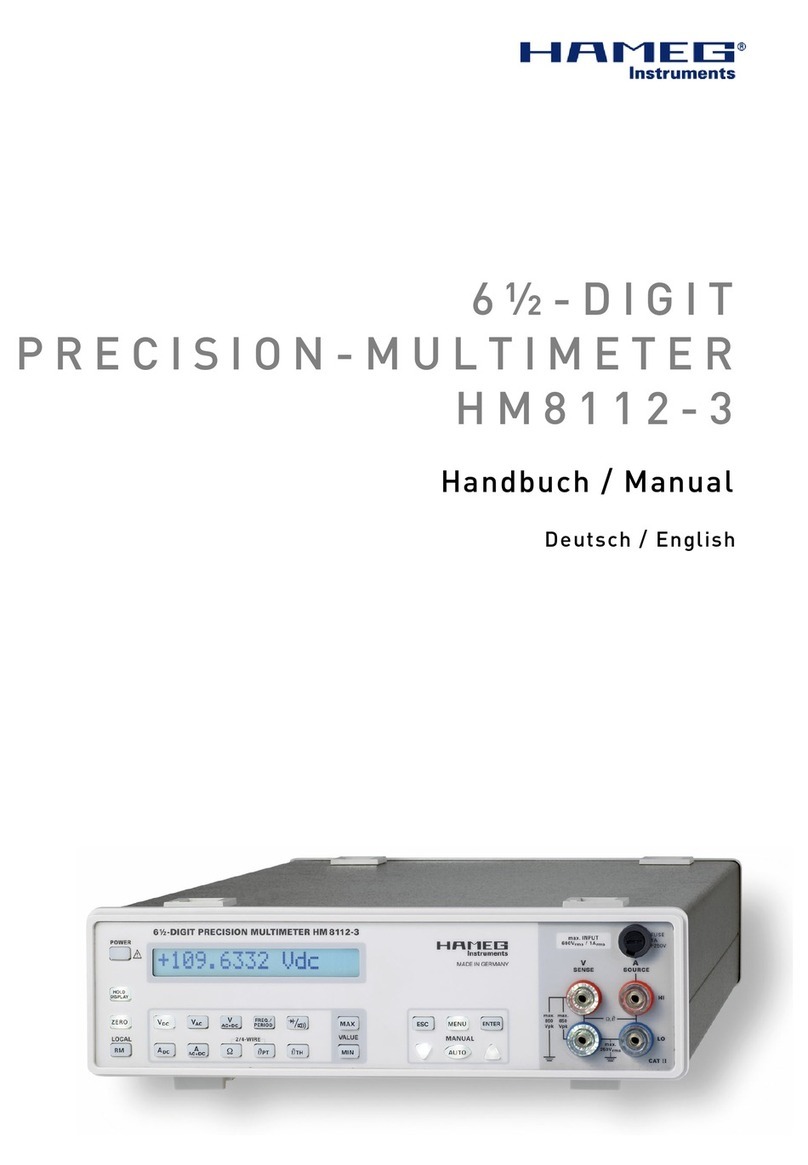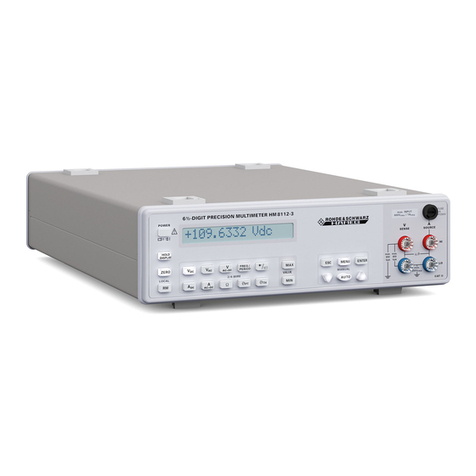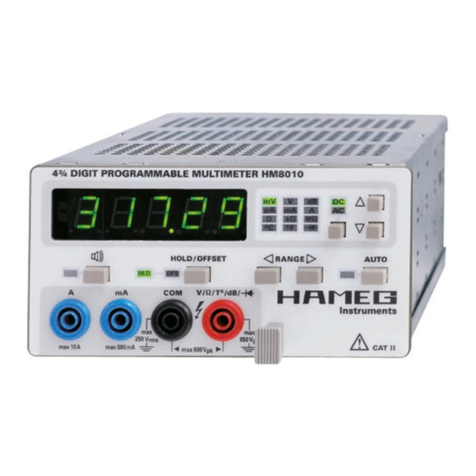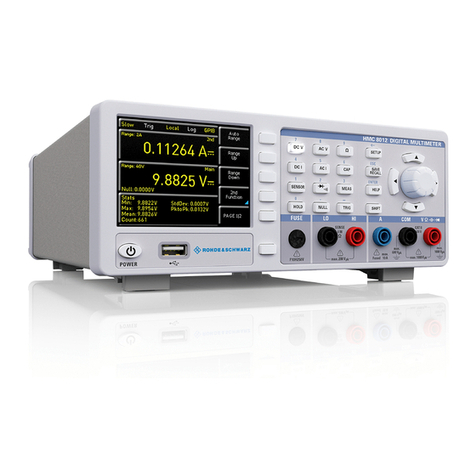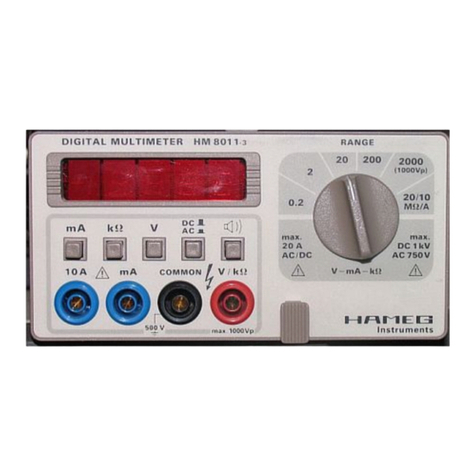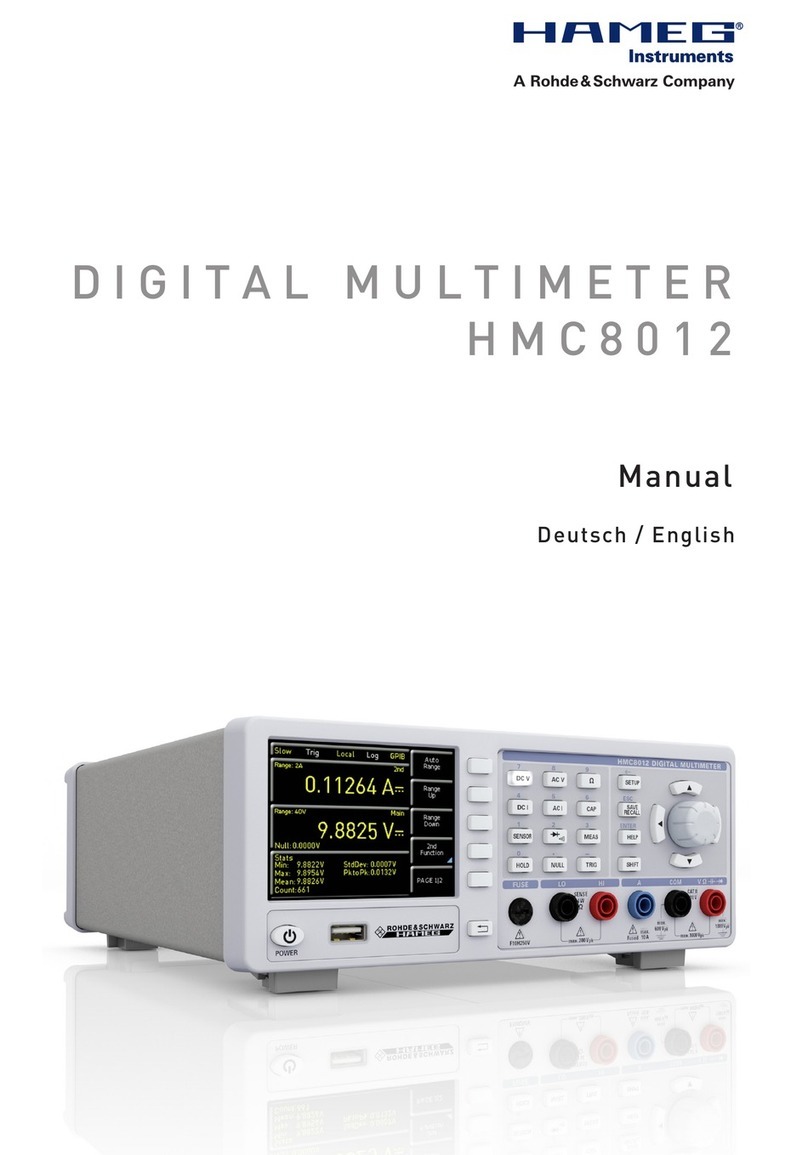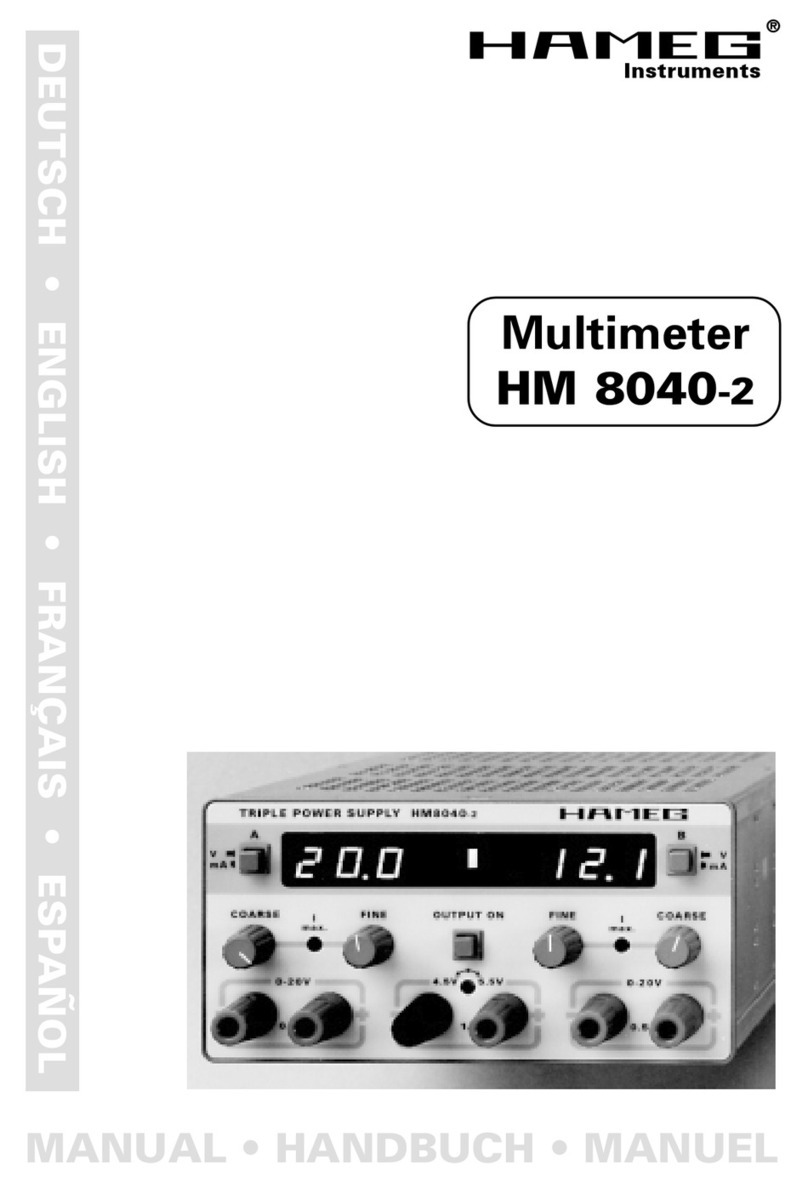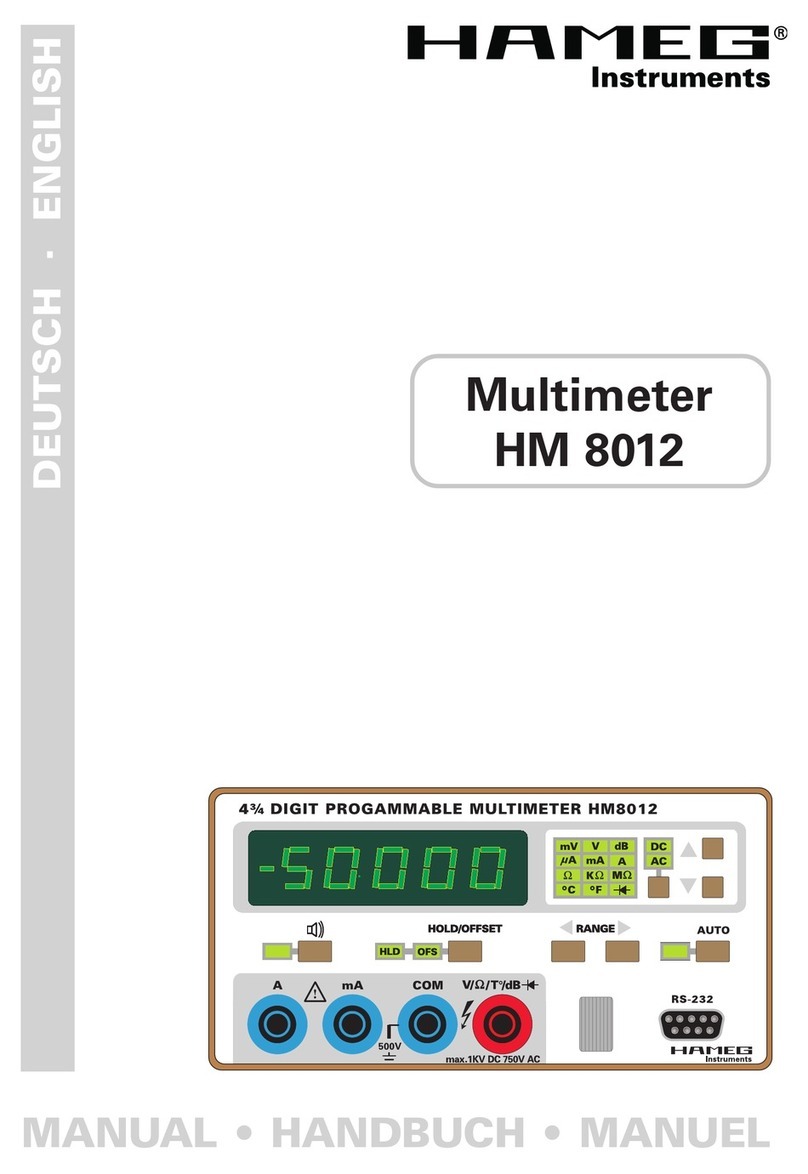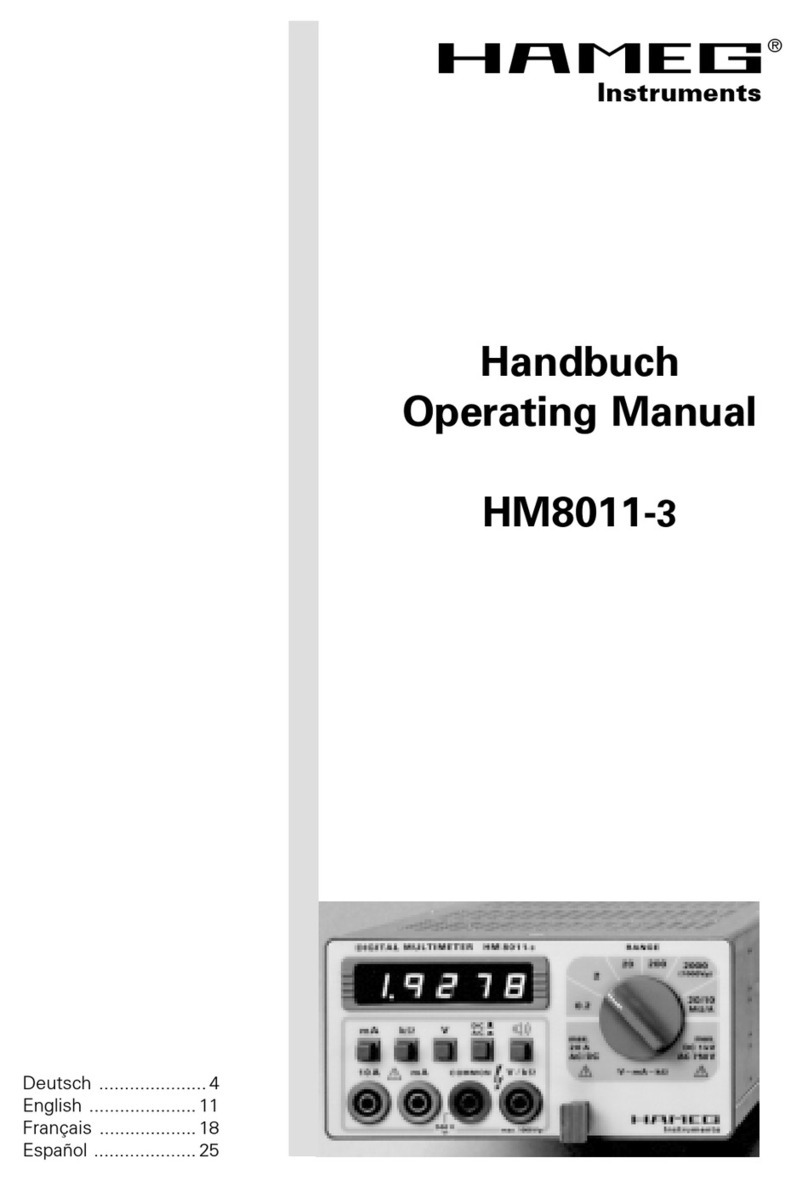
35
Subject to change without notice
Specifications
6½-Digit Precision-Multimeter HM8112-3
SPECIFICATIONS
Valid at 23 degrees °C after a 30 minute warm-up period
Included in delivery:
Multimeter HM8112-3, line cord, manual, HZ15 measuring cables
Accessories optional:
HZ887: Temperataure sensor (PT100; -50°C...+400°C )
HZ42:19" Rackmount-kit 2RU for frame height 75mm
DC Specifications
Ranges: 0.1 V; 1 V; 10 V; 100 V; 600 V
Input impedance:
0.1 V; 1.0 V >1 GΩ
10 V; 100 V; 600 V 10 MΩ
Accuracy: Values given are in ±(% of reading + % of full scale)
1 year; 23 ±2 °C Temperature coefficient
Range % rdg. + % f.s. 10...21 °C + 25...40 °C
0.1 V 0.005 + 0.0006 0.0008
1.0 V 0.003 + 0.0006 0.0008
10.0 V 0.003 + 0.0006 0.0008
100.0 V 0.003 + 0.0006 0.0008
600.0 V 0.004 + 0.0006 0.0008
Integration time: 0.1 sec 1 to 60 sec
Display range: 120,000 digit 1,200,000 digit
600 V range: 600,00 digit 600,000 digit
Resolution: 1 µV 100 nV
Zero point
Temperature coefficient: ≤0,3 µV/°C
Long term stability: ≤3 µV for 90 days
AC specifications
Ranges: 0.1 V; 1 V; 10 V; 100 V; 600 V
Measuring method: true rms DC or AC coupled
(except 0.1 V range)
Input impedance:
0.1 V: 1 GΩII <60 pF
1 V to 600 V: 10 MΩII <60 pF
Response time: 1.5 sec to within 0,1% of rdg.
Accuracy: For sine wave signals >5% of range.
Values given are in ±(% rdg. +% f.s.);23 ±2 °C for 1 year
Range 20 Hz – 1 kHz – 10 kHz – 50 kHz – 100 kHz –
1 kHz 10 kHz 50 kHz 100 kHz 300 kHz
0.1 V 0.10 +0.08 5+0.5 (5 kHz)
1.0 V 0.08 +0.08 0.15+0.08 0.3+0.1 0.8+0.15 7+0.15
10.0 V 0.08 +0.08 0.10+0.08 0.3+0.1 0.8+0.15 4+0.15
100.0 V 0.08 +0.08 0.10+0.08 0.3+0.1 0.8+0.15
600.0 V 0.08 +0.08 0.10+0.08
Temperature coefficient 10...21°C and 25...40°C; (%rdg. + %f.s.)
at 20 Hz - 10 kHz: 0.01 + 0.008
at 10 kHz - 100 kHz: 0.08 + 0.01
Crest factor: 7:1 (max. 5 x range)
Integration time: 0.1 sec 1 to 60 sec
Display range: 120,000 digit 1,200,000 digit
600 V range: 60,000 digit 600,000 digit
Resolution: 1 µV 100 nV
Overload protection:
(V-HI to V- LO) and to chassis:
Measurement ranges: all
all the time 850 Vpeak or 600 VDC
Maximum input voltage LOW against
chassis/safety earth: 250 Vrms at max. 60 Hz or 250 VDC
Current specifications
Ranges: 100 µA; 1 mA; 10 mA; 100 mA; 1 A
Integration time: 0.1 sec 1 to 60 sec
Display ranges: 120,000 digit 1,200,000 digit
1 A range: 100,000 digit 1,000,000 digit
Resolution: 1 nA 100 pA
Accuracy: DC 45 Hz–1 kHz 1 kHz–5 kHz
(1 year; 23 ±2 °C) 0.02+0.002 0.1+0.08 0.2+0.08
Temperature coefficient: 10...21 °C 25...40 °C
(% rdg. + % f.s.): 0.002+0.001 0.01+0.01
Voltage: <600 mV to 1,5 V
Response time: 1.5 sec to within 0.1% of rdg.
Crest factor: 7:1 (max. 5 x range)
Overload protection: Fuse FF 1 A 250 V
Resistance specifications
Ranges: 100Ω, 1kΩ, 10kΩ, 100kΩ, 1MΩ, 10MΩ
Integration time: 0.1 sec 1 to 60 sec
Display ranges: 120,000 digit 1,200,000 digit
Resolution: 1mΩ100 µΩ
Accuracy: Values given are in ±(% rdg. + % f.s.)
1 year; 23 ±2°C Temperature coefficient/°C
Range %rdg. + %f.s. 10...21 °C and 25...40 °C
100 Ω0.005 + 0.0015 0.0008
1 kΩ0.005 + 0.001 0.0008
10 kΩ0.005 + 0.001 0.0008
100 kΩ0.005 + 0.001 0.0008
1 MΩ0.05 + 0.002 0.002
10 MΩ0.5 + 0.02 0.01
Measuring current: Range Current
100 Ω, 1kΩ1 mA
10 kΩ100 µA
100 kΩ10 µA
1 MΩ1 µA
10 MΩ100 nA
max. measuring voltage: approx. 3 V
Overload protection: 250 Vpeak
Temperature measurement specifications
PT100 / PT1000 (EN60751) 2- or 4-wire measurements
Range: –200 °C to +800 °C
Resolution: 0.01 °C; measuring current 1mA
Accuracy: ±(0.05 °C + tolerance of sensor +0.08 K)
Temperature coefficient
(10...21 °C + 25...40°C: <0.0018 °C/°C
NiCr-Ni (K-Type)
Range: –270 °C to +1372 °C
Resolution: 0.1 °C
Accuracy: ±(0.7% rdg. +0.3 K)
Fe-CuNi (J-Type)
Range: –210 °C to +1200 °C
Resolution: 0.1 °C
Accuracy: ±(0.7% rdg. +0.3 K)
Frequency and period specifications
Range: 1 Hz to 100 kHz
Resolution: 0.00001 Hz to 1 Hz
Accuracy: 0.05% (rdg.)
Measuring time: 1 to 2 sec
RS-232 Interface
RS-232 standard: 9600 or 19200 Baud
Functions: Control / Data fetch
Inputs: Function, range, integration time, start
command
Outputs: Measurement results, function, range,
integration time (10 ms to 60 s)
Miscellaneous
Time to change range or function:
approx. 125 ms with DC voltage, DC current, resistance
approx. 1 sec with AC voltage, AC current
Memory: 30.000 readings / 128 kB
Protective class: I, EN 61010 (IEC 1010)
Power supply: 105–254 V; 50/60 Hz
Power consumption: approx. 8 W
Operating temperature: +10 °C....+40 °C
Storage temperature: –40 °C....+70 °C
Humidity: <75 %, no condensation
Size (W x H x D): 285 x 75 x 365 mm
Weight: approx. 3 kg
Optionen: USB- bzw. IEEE-Schnittstelle
Subject to change without notice
Test Equipment Depot - 800.517.8431 - 99 Washington Street Melrose, MA 02176
FAX 781.665.0780 - TestEquipmentDepot.com
